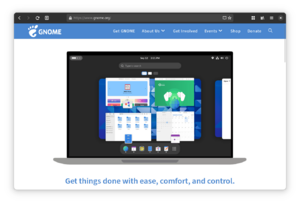WebKit facts for kids
 |
|
| Original author(s) | Apple Inc. |
|---|---|
| Developer(s) | Apple Inc., Adobe Systems, Sony, KDE, Igalia, and others |
| Initial release | November 4, 1998 (KHTML released) June 7, 2005 (WebKit sourced) |
| Preview release |
Nightly
|
| Written in | C++ |
| Operating system | macOS, iOS, Linux, Microsoft Windows |
| Type | Browser engine |
| License | LGPLv2.1 (rendering engine, JavaScript engine), BSD 2-Clause (additional contributions from Apple) |
WebKit is like the "engine" inside many web browsers and apps. It's a special piece of software that helps your computer or phone show you websites. Think of it as the part that understands the code of a webpage and draws it on your screen.
WebKit is mostly known for being used in Apple's Safari web browser. It's also used by all web browsers on iOS and iPadOS devices, like iPhones and iPads. Besides Apple products, WebKit powers web features on PlayStation consoles (starting with PS3), Amazon Kindle e-readers, and some Nintendo consoles.
Many different companies and groups have helped develop WebKit. These include Apple, Google, Sony, and KDE. WebKit works on many different computer systems, such as macOS, Windows, and Linux.
In 2013, Google created its own version of a part of WebKit called WebCore. They named their new engine Blink. This Blink engine is now used in Google Chrome and Opera web browsers.
WebKit is an open source project. This means its code is available for anyone to see and use, which helps many developers work on it and make it better.
Contents
How WebKit Started
The story of WebKit began in 1998 with two projects from KDE, a group that makes free software. These projects were called KHTML (for showing web pages) and KJS (for running JavaScript code).
In 2001, Apple started its own version of these KDE projects. This is called a "fork" in the software world. Apple renamed KHTML to WebCore and KJS to JavaScriptCore. They did this because KHTML and KJS were well-designed and followed web standards.
Apple made some changes to these parts to work better with their macOS computers. At first, sharing code between Apple and KDE was a bit tricky because they had different ways of working. However, over time, Apple made more of WebKit's code open for everyone to see and use. This helped improve both WebKit and KHTML.
In 2005, Apple officially made WebKit an open-source project. This meant that more people could help develop it.
Making WebKit Better
Since it became open source, WebKit has gained many new features.
- In 2007, developers added support for cool CSS effects like animations and transitions, which make websites look more dynamic.
- In 2007, WebKit also added support for HTML5 video. This allowed websites to play videos directly without needing extra programs.
- In 2008, the team made JavaScript run much faster. They created something called "SquirrelFish" and then "SquirrelFish Extreme" (SFX). These technologies help turn JavaScript code into something computers can understand and run very quickly.
WebKit2: A New Design
In 2010, a new project called WebKit2 was announced. The goal was to redesign WebKit to make it more stable and secure. Imagine if one part of a webpage crashed; with WebKit2, it was designed so that only that part would crash, not the whole browser. This makes web browsing smoother.
Safari for macOS and iOS later switched to using this newer WebKit2 design.
Where WebKit is Used

WebKit is the main "engine" for Safari on Apple devices. It was also used by Google Chrome on Windows, macOS, and Android for a while. However, Chrome later switched to its own engine called Blink, which, as mentioned, started from WebKit. Chrome on iOS still uses WebKit because Apple requires all browsers on iPhones and iPads to use it.
Many other apps on macOS and iOS also use WebKit to show web content. For example, Apple's Mail app uses it to display emails that have pictures and fancy layouts.
Devices and Browsers Using WebKit
WebKit is used in many different places:
- Mobile Phones: Older Symbian phones and BlackBerry phones used WebKit-based browsers. The Android web browser also used WebKit before version 4.4 KitKat.
- Game Consoles: The web browser on the PlayStation 3 system software (from version 4.10) uses WebKit.
- E-readers: The Amazon Kindle 3 has an experimental WebKit-based browser.
- Other Browsers: Browsers like Midori, OmniWeb, iCab, and Web (formerly Epiphany) use WebKit.
- Applications: WebKit helps display web content in applications like Adobe Integrated Runtime and parts of Adobe Creative Suite CS5.
By 2015, WebKit-based browsers were very popular, making up about 50% of the web browser market share.
WebKit on Different Systems
WebKit has been adapted to work on many different computer systems and devices.
- Mobile Devices: Apple ported WebKit to iOS for the iPhone, iPod Touch, and iPad. Nokia also ported it to the Symbian operating system for their mobile phones.
- Windows: Apple ported WebKit to Microsoft Windows for Safari. Even though Safari for Windows is no longer updated, WebKit is still used in other Apple software on Windows, like iCloud and iTunes.
- Linux: WebKit has been ported to toolkits like GTK for Linux. This version, called WebKitGTK, is used by browsers like GNOME Web.

- Embedded Systems: There's a special version called Origyn Web Browser (OWB) designed to make it easier to use WebKit on smaller, embedded devices like set-top boxes.
Web Platform for Embedded (WPE)
Web Platform for Embedded (WPE) is another version of WebKit made specifically for embedded devices. It's designed to be very efficient and is used in things like smart TVs and digital signs.
Google's Blink Fork
On April 3, 2013, Google announced that it was creating its own separate version, or "fork," of WebKit's WebCore component. They named this new engine Blink. Google decided to do this to have more freedom to make changes and simplify the code for their Google Chrome browser. The Opera web browser also switched to using Blink.
WebKit's Main Parts
WebCore
WebCore is the part of WebKit that handles the "layout" and "rendering" of web pages. This means it figures out where everything should go on the page and then draws it. It also works with the Document Object Model (DOM), which is how web pages are structured. WebCore is licensed under the GNU Lesser General Public License (LGPL), meaning it's open for everyone to use and change.
WebKit is known for being very good at following web standards. It passes special tests like Acid2 and Acid3, which check how well a browser engine displays complex web pages.
JavaScriptCore
JavaScriptCore is the part of WebKit that runs JavaScript code. JavaScript is a programming language that makes websites interactive, allowing for things like animations, games, and forms that respond to what you type.
JavaScriptCore started from KDE's KJS engine. Over the years, it has been greatly improved to run JavaScript much faster. As mentioned earlier, "SquirrelFish" and "SquirrelFish Extreme" (SFX) were big steps in making JavaScript execution super speedy.
In 2014, an even faster system called FTL (which stands for "Fourth-Tier-LLVM" and unofficially "faster-than-light") was introduced. This system helps turn JavaScript into highly optimized code that computers can run very quickly.
See also
 In Spanish: WebKit para niños
In Spanish: WebKit para niños
- Comparison of browser engines
- List of WebKit-based browsers

